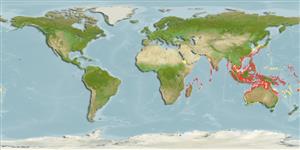Teleostei (teleosts) >
Ovalentaria/misc (Various families in series Ovalentaria) >
Ambassidae (Asiatic glassfishes)
Etymology: Ambassis: Derived from Greek, anabasis = climbing up (Ref. 45335).
More on author: Bleeker.
Environment: milieu / climate zone / depth range / distribution range
Ecology
Marine; freshwater; brackish; demersal; amphidromous (Ref. 51243). Tropical
Indo-Pacific: East Africa to the Philippines, Fiji and Carolines, north to Sagami Bay, Japan (Ref. 559).
Size / Weight / Age
Maturity: Lm ? range ? - ? cm
Max length : 14.0 cm TL male/unsexed; (Ref. 637)
Dorsal spines (total): 8; Dorsal soft rays (total): 9 - 10; Anal spines: 3; Anal soft rays: 9 - 10. Body all silvery and translucent with a dusky midlateral band. Back margin evenly dark. Membrane between 2nd and 3rd dorsal spine blackish. Mouth strongly oblique. Margin almost straight from the origin of the 1st dorsal snout.
Body shape (shape guide): fusiform / normal; Cross section: compressed.
Common in brackish waters near river mouths where it occurs in schools; sometimes found in upper streams (Ref. 559). Mainly marine but enters rivers (Ref. 4967).
Life cycle and mating behavior
Maturity | Reproduction | Spawning | Eggs | Fecundity | Larvae
Masuda, H., K. Amaoka, C. Araga, T. Uyeno and T. Yoshino, 1984. The fishes of the Japanese Archipelago. Vol. 1. Tokai University Press, Tokyo, Japan. 437 p. (text). (Ref. 559)
IUCN Red List Status (Ref. 130435: Version 2025-1)
Threat to humans
Harmless
Human uses
Tools
Special reports
Download XML
Internet sources
Estimates based on models
Preferred temperature (Ref.
123201): 24.9 - 29, mean 28.1 °C (based on 882 cells).
Phylogenetic diversity index (Ref.
82804): PD
50 = 0.5000 [Uniqueness, from 0.5 = low to 2.0 = high].
Bayesian length-weight: a=0.01230 (0.00666 - 0.02273), b=3.00 (2.84 - 3.16), in cm total length, based on LWR estimates for this species & Genus-body shape (Ref.
93245).
Trophic level (Ref.
69278): 3.4 ±0.4 se; based on size and trophs of closest relatives
Resilience (Ref.
120179): High, minimum population doubling time less than 15 months (Assuming Fec > 10,000).
Fishing Vulnerability (Ref.
59153): Low vulnerability (10 of 100).
🛈
